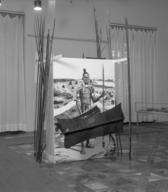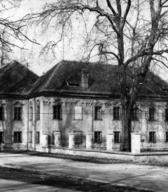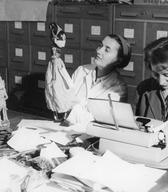Intertwined Worlds
In 2024, the Slovene Ethnographic Museum marks the 60th anniversary of the establishment of the Museum of Non-European Cultures in Goričane. On this occasion, we are opening the exhibition Intertwined Worlds: The Non-European Collections in the time of the Non-Aligned Movement by the authors Dr Tina Palaić and Dr Marko Frelih.
Museum of Non-European Cultures in Goričane
The Museum of Non-European Cultures was the first Yugoslav institution dedicated to collecting and exhibiting ethnological objects from other continents. It operated between 1964 and 2001 as a dislocated unit of the Slovene Ethnographic Museum with premises in the baroque Goričane manor near Medvode. Curator Dr. Pavla Štrukelj managed the non-European collections until her retirement in 1990, when she was replaced by curator mag. Ralf Čeplak Mencin. The Museum of Non-European Cultures housed and exhibited collections from other continents gathered in the 19th and first half of the 20th centuries. It also acquired new collections, which were most often the result of various contacts and exchanges between Yugoslavia and developing countries within the framework of the Non-Aligned politics. During the period of its activity, over eighty exhibitions were organized, almost half of which were traveling exhibitions prepared by developing countries. For many visitors, the museum functioned as a window into the world, bringing them closer to other continents and diverse cultures. The manor, which was acquired by the then director of the Slovene Ethnographic Museum, Dr Boris Kuhar, remained active until 2001, when its collections were transferred back to the Slovene Ethnographic Museum.
About the exhibition Intertwined Worlds: The Non-European Collections in the time of the Non-Aligned Movement
The peak of the relations between the Slovenian territory and the countries of the Global South dates to the period following the Second World War which was marked also by the Non-Aligned Movement (NAM). NAM connected many independent countries, mostly with the colonial past, that emerged after the Second World War. Socialist Yugoslavia, one of the movement's founding countries, established links with developing countries in the political, economic, scientific, and technological spheres.
Dr Tina Palaić and Dr Marko Frelih, the authors of the exhibition Intertwined Worlds: The Non-European Collections in the time of the Non-Aligned Movement, highlighted the close cooperation in the field of culture at that time.
Culture and heritage played an important role in the new countries that gained independence from colonial powers in the decades after World War II. They were an important basis for demands for independence, and at the same time, with their long cultural traditions, the former colonies were consolidating their new place in the global system. With the exhibition, we shed light on only a part of the international cooperation and exchanges in the cultural field, in which socialist Yugoslavia participated, and which significantly broadened the horizons and perspectives of everybody involved.
Dr Tina Palaić, author and curator
On the one hand, the exhibition sheds light on the exhibition activities of the Museum of Non-European Cultures in Goričane. With their original and traveling exhibitions, the Museum most often emphasised the importance of the national liberation struggle as a connecting element with nations from other continents, highlighted the policy of Non-Alignment and advocated anti-colonialism. Exhibition narratives, however, also helped to promote national identity by emphasizing the role of Slovenian collectors, as well as contribute to the exoticization of the Other. Photographs, exhibition catalogues and posters, as well as excerpts from newspapers and publications, shed light on how other continents and the lives of people there were perceived at the time.
On the other hand, the exhibition illustrates professional exchanges between Non-Aligned countries highlighting the stories of three curators who, as museum experts, developed unique relationships with the African continent. The experiences of three women are linked by their endeavors to advance scientific and museum work on the African continent. Dr Pavla Štrukelj, curator at the Museum of Non-European Cultures, organised several original and traveling exhibitions from African countries, and she also visited many on professional and private occasions. Dr Bernarda Perc, curator at the Regional Museum Ptuj, studied in Cairo and Munich and, as the first Slovene Egyptologist, aspired to develop this discipline in Slovenia. Dr Štefka Cobelj, director of the Regional Museum Ptuj, contributed to the development of museology in Somalia as a museum consultant after retiring.




